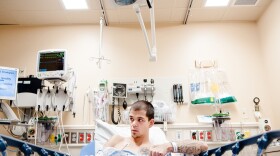When wounded combat veterans lash out, the Army struggles to respond justly.
Locked Away: Army Struggles With Wounded Soldiers
Sgt. Paul Sasse arrived at Fort Carson in February in a uniform glistening with decorations from three combat tours: five medals for heroism, four for excellence, three for good conduct and one for nearly getting killed in Iraq. The 32-year-old Special Forces soldier also wore shackles. He was facing court-martial for assaulting his wife and two military police officers. Sasse had been sitting in solitary confinement at the El Paso County jail for months without military charge and had been brought to the Colorado Springs Army post to be arraigned. “I just need someone to help me,” he said, reaching with bound hands to show a Gazette reporter his medical files.

Sasse was hit by a roadside bomb in 2007 in Iraq and diagnosed with a traumatic brain injury. He kept soldiering through another tour even though he struggled with shattered memory and concentration, depression, nightmares and rage.
In 2012, the Army diagnosed him with post-traumatic stress disorder. Doctors gave him a mix of contraindicated drugs that made him manic. A few weeks later, he slammed his wife’s head against their Jeep until she was covered in blood then turned on the military police who tried to stop him. He had been scheduled to go into a special unit for wounded soldiers. Instead, the Army put him in jail.

In the El Paso County jail, Sasse picked up three more assault charges for resisting guards. He ended up in solitary. He sat there for almost nine months, growing a long, bushy beard and developing, an Army doctor wrote in January, “severe psychiatric disease.”
“Given his condition, his confinement is tantamount to cruel and unusual punishment,” Fort Carson’s top defense attorney said in a letter to Fort Carson’s commander in September, asking the general to send Sasse to a psychiatric hospital.
Still, the Army left him in solitary.
His family pleaded to the commander and their hometown senator to intervene to no avail.
If convicted and thrown out of the Army, Sasse had a plan: go to the steps of the Capitol in Washington, D.C., lay his thick stack of medical records on the steps then set himself on fire.
“It’s the only way I can get anyone to listen,” he said as guards took him away.
Wounds Cause Misconduct
At the end of the longest period of war in American history, no one knows how many troops like Sasse are suffering from invisible injuries through one deployment after another, ready to break. Of the 2.5 million troops who have deployed for the Iraq and Afghanistan wars since 2001, more than 400,000 have deployed three times or more. Each time, they are more likely to develop TBI, PTSD and other psychological problems, Department of Defense studies show.
Repeated studies also show these invisible injuries dramatically increase the likelihood that troops will act out and be kicked out with no benefits. Often, the wounds take years to develop, which means the country will be dealing with the wounded long after the wars are done.
This week, a Gazette investigation has shown that the number of soldiers discharged Army-wide for misconduct has increased every year since 2006 and is up more than 60 percent in that time, according to records obtained through the Freedom of Information Act. The 76,000 soldiers kicked out since 2006 from posts all over the country include an unknown number who have deployed multiple times and have PTSD or TBI. Even soldiers with obvious physical wounds are not protected from quick discharge for breaking the rules. Neither are soldiers like Sasse, who have considerable combat exposure and long records of meritorious service.
“It’s despicable,” said retired Special Forces Staff Sgt. Jason Inman, who shared a Humvee in Iraq with Sasse. “Guys get in trouble and the Army makes it look like the soldier’s fault and kicks them out when it’s the Army that made them this way.”
--
This excerpt is part of a special series by Dave Philipps and published by the Colorado Springs Gazette. It is republished here with permission.





